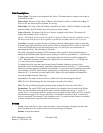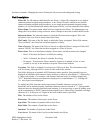the data or metadata. Changing the state to Destroyed will prevent both reading and writing.
Field Descriptions
Fileset ID. The ID number which identifies the fileset. A fileset ID is displayed as two double-
comma-separated unsigned integer numbers. A new Fileset ID can be entered as two double-
comma-separated unsigned integer numbers, as two single-period-separated unsigned integer
numbers, as a 64-bit hexadecimal number that begins with '0x', or as an unsigned 64-bit number.
Fileset Name. The unique name which has been assigned to the fileset. The administrator can
change the Fileset Name as long as the new name is unique to the realm in which HPSS resides
Subsystem Name. The subsystem name to which the fileset has been assigned. This is the
subsystem of the Core Server which controls the fileset.
File Family. The name of the file family to which the fileset is assigned. If this field contains
"Not in a family", the fileset has not been assigned to a family.
Class of Service. The name of the Class of Service to which the fileset is assigned. If this field
contains "NONE", the fileset has not been assigned to a Class of Service.
Fileset State. This set of checkboxes displays fileset states, and allows them to be changed.
• Read - If checked, the fileset is available for reading.
• Write - If checked, the fileset is available for writing.
• Destroyed - If checked, the fileset cannot be written to or updated; in fact, it is not
possible to set any of the attributes except the Fileset State attribute.
User Data. This field is available for storing up to 128 bytes of data. The information can be
ASCII or binary, although ASCII is easier to work with in this window.
The field is displayed as printable ASCII characters where possible. Non-printable bytes are
displayed in backslash-octal notation, where each byte is shown as a backslash ("\") followed by
a 3-digit octal number. For example, a tab character (decimal value 9) would be displayed as
"\011". Backslash characters are themselves displayed as two backslashes ("\\"). Trailing null
(i.e., zero) bytes are not displayed.
To modify this field, enter data in the same format. Printable characters (except for the
backslash) can be entered normally. Backslash characters must be entered as "\\". Non-printable
characters must be entered in backslash-octal notation. It is not necessary to specify leading zeros
on the octal numbers, EXCEPT when the non-printable byte is followed by a printable octal digit
character (0-7). In that case, all 3 digits of the octal number must be specified.
Files. The number of files in this fileset.
Directories. The number of directories in this fileset.
Sym Links. The number of symbolic links in this fileset.
Hard Links. The number of hard links in this fileset.
Junctions. The number of junctions in this fileset.
Core Server. The name of the Core Server that handles this fileset.
HPSS Management Guide November 2009
Release 7.3 (Revision 1.0) 313


















